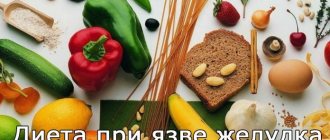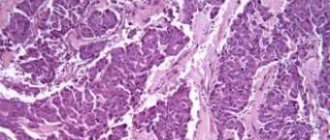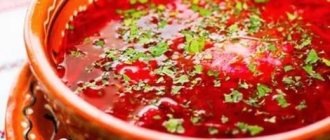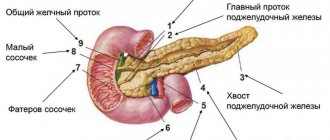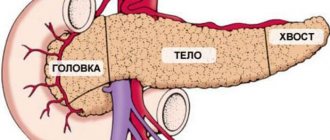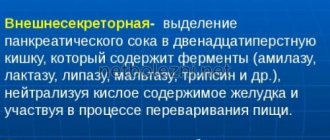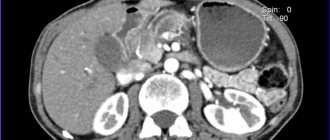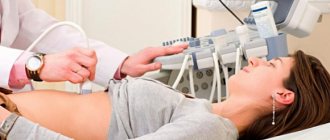General rules
The pancreas is an important organ of the digestive system as it is responsible for producing digestive enzymes and the hormone insulin , which controls blood sugar levels. Pancreatic cancer is a serious disease with a poor prognosis.
Oncological disease negatively affects the functioning of the organ, and treatment is complicated by the inability to diagnose it in the early stages. In this case, rapid metastasis is observed. The results of surgical treatment (even after radical resection of the R0 tumor) leave much to be desired. First of all, only 10-20% of cases have a resectable tumor. Low resectability is explained by the high incidence of locally advanced disease or metastasis, as well as the technical difficulties of the operation itself. Therefore, surgical intervention alone does not provide good results, and its addition with chemoradiotherapy improves the survival of patients.
After treatment, therapeutic nutrition plays a special role. It is aimed at suppressing hyperenzymeemia, reducing the load on the digestive tract as a whole, improving metabolic processes in the pancreas and restoring its function (as far as possible).
Proper nutrition for pancreatic cancer allows you to:
- stabilize the patient’s well-being;
- slightly reduce the manifestations of the disease;
- prevent weight loss;
- normalize blood sugar levels.
Main characteristics of the diet
- Food should be easily digestible.
- Dishes are only boiled and steamed. The degree of grinding depends on the patient’s condition, so it can be liquid, puree, pureed or thoroughly crushed.
- Fat content is extremely limited or eliminated. In stage 4 cancer, fat is not digested, causing diarrhea .
- Avoid foods with a strong smell and taste (sour, spicy, salty). Food should be neutral, as strong odors can cause nausea and provoke vomiting. If you feel the urge to vomit, stop eating.
- Emphasis on the consumption of protein dishes (cottage cheese, cheese, lean fish, fermented milk products, eggs, dietary meat).
- Eating two servings of vegetables and two servings of fruit daily. Most often they are subjected to heat treatment, since in their raw form they can cause discomfort, bloating and worsen the patient’s condition.
- Do not overload the stomach and digestive system - split meals (5 times a day) in small portions are recommended. On the other hand, you should not eat food forcefully, trying to adhere to the regime. In the absence of appetite, it may change. In some cases, medications that improve appetite are prescribed.
- On the recommendation of a doctor, it is possible to take enzymes to improve food digestion.
- Replacement therapy is justified in this case, since pancreatic function is affected.
- Maintaining an adequate drinking regime (herbal teas, diluted juices without sugar, decoctions of dried fruits, filtered water).
- Limit the amount of salt (6-8 g).
- Avoiding refined sugar.
- Exclusion of extractives and coarse fiber. To further extract substances from meat, cook it in small pieces, draining the water several times after 10 minutes. Ready meat is used for further preparation (puddings, soufflés, minced meat).
When metastasis occurs, the target becomes the liver, gall bladder or stomach; this certainly worsens the patient’s condition and requires an even more careful attitude to one’s diet. It is especially important for liver damage, which reduces its detoxification function and is unable to neutralize carcinogenic substances (nitrates, GMOs, food coloring, additives and stabilizers). The food should be natural, and in order to reduce the nitrate content, soak vegetables and fruits and remove the peels.
Pancreatic cancer - symptoms and treatment
Treatment of pancreatic cancer involves the use of surgical and chemotherapy methods.
Features of treatment at different stages
When surgery is needed for pancreatic cancer depends on the histological form of the disease and its stage.
For pancreatic adenocarcinoma, radical surgical treatment (complete removal of the tumor) is possible only in stages I and II, then courses of chemotherapy . In stage III of the disease, chemotherapy is first administered, and then, if there are positive dynamics, radical surgical treatment is performed. In stage IV, only courses of chemotherapy are carried out, and surgical treatment is aimed at eliminating complications of the disease.
For neuroendocrine tumors of the pancreas, surgical treatment is possible at any stage of the disease, followed by courses of chemotherapy. The extent of surgery for these tumors is determined individually and depends on the extent of the disease and the experience of the operating team.
For other histological forms of pancreatic cancer, the tactics are identical to the treatment tactics for adenocarcinoma.
Surgery
Whipple operation for pancreatic cancer (pancreaticoduodenectomy). If the tumor is localized in the head of the pancreas, then gastropancreaticoduodenal resection (Whipple procedure) is performed, during which the head of the pancreas, duodenum, part of the stomach, proximal small intestine, gall bladder, and bile ducts are removed. Subsequently, anastomosis is performed between the remaining part of the pancreas and the digestive tract, bile ducts and intestines, stomach and intestines.
Distal pancreatectomy. When the tumor is localized in the body of the pancreas, distal resection of the pancreas or isolated resection of the body of the pancreas is performed, with the formation of an anastomosis between the tail of the pancreas and the gastrointestinal tract.
If the malignancy is located in the tail of the pancreas, the tail of the pancreas is removed with removal or preservation of the spleen.
Total pancreatectomy. In case of total damage to the pancreas, the only possible surgical intervention is complete removal of the gland. Recently, due to the availability of good replacement therapy (insulin therapy and correction of enzyme deficiency), this operation is advisable only in some cases.
Nano-knife in the treatment of pancreatic cancer. The effectiveness of using a nanoknife for the treatment of pancreatic cancer has not yet been proven.
All operations on the pancreas are associated with a large number of complications. The only factor that can reliably reduce the incidence of complications is the experience of the surgeon performing this surgical treatment. It has been proven that when more than 20 gastropancreaticoduodenal resections are performed per year, the mortality rate is less than 2%, but if 5-15 such operations are performed, the mortality rate is 15-20%.
Thus, the only radical treatment for pancreatic cancer is surgery followed by courses of chemotherapy.[7]
Radiation therapy for pancreatic cancer
In case of stage III of the disease, the absence of effect from chemotherapy treatment and the impossibility of surgical intervention, stereotactic radiation therapy is indicated.
Stereotactic radiation therapy (SRT) is a modern method of radiotherapy in which high doses of ionizing radiation are delivered to the target area in a small number of fractions.
Treatment of malignant pancreatic tumors with liver metastases
For neuroendocrine tumors of the pancreas, surgical treatment can be performed even in the presence of metastatic foci. For other histological forms of pancreatic cancer with metastatic liver disease, only chemotherapy treatment is indicated.
Pain relief for pancreatic cancer
Taking painkillers for pancreatic cancer is necessary only when pain occurs. First, the patient is prescribed non-narcotic analgesics, and if they are ineffective, narcotic drugs are prescribed.
Nutrition for pancreatic cancer
There is no special diet for pancreatic cancer. The diet must be followed after pancreatic surgery (Table No. 5A or Table No. 9 if the patient has diabetes).
Authorized Products
Diet for pancreatic cancer includes:
- Soups made with vegetable broths. You can make puree soups. Cereals (semolina, rice, rolled oats) and pureed boiled vegetables are added to soups. Vegetables for soups cannot be fried.
- Lean veal, beef, chicken, rabbit, boiled and steamed turkey. Only chopped products are recommended (meatballs, cutlets, souffles, dumplings, meatballs). You can add boiled pureed vegetables to minced meat - this will add juiciness and taste to the minced meat. Souffles and purees are also prepared from the boiled pulp of the bird.
- Low-fat fish (cod, pike, pike perch, hake, pollock, carp, perch, whiting) boiled or steamed, soft fish can be eaten in pieces, disassembled into fibers. Poached fish is not allowed, as it contains more extractive substances than boiled fish.
- Boiled and grated vegetables: potatoes, pumpkin, zucchini, carrots, cauliflower, green peas, beets. If tolerance is poor, the list of vegetables is reduced. White cabbage and legumes are limited or excluded due to the possibility of causing gas formation.
- Cereals: buckwheat, rice, semolina and oatmeal. Boil it in water and grind it to a viscous consistency. Using buckwheat and rice flour speeds up cooking.
- Wheat bread that is stale or dried out, unhealthy biscuits (biscuits).
- Low-fat dairy products, cottage cheese in its natural form, as part of puddings, casseroles, soufflés. If you have a calcium deficiency, you can prepare calcined cottage cheese. Whole milk usually causes bloating and diarrhea, so it is carefully introduced into the diet in the form of additives to omelets and cereals.
- Protein omelettes. You can have 1 soft-boiled egg per day.
- Baked sweet apples, jelly and jelly made from fruits and berries. You can try introducing raw pureed fruits and berries.
- Butter in dishes (10-15 g per day).
- Fruit juices diluted with water, weak tea with lemon, rosehip infusion, still table water, compotes (from fresh and dried fruits).
Table of permitted products
| Proteins, g | Fats, g | Carbohydrates, g | Calories, kcal | |
Vegetables and greens | ||||
| zucchini | 0,6 | 0,3 | 4,6 | 24 |
| broccoli | 3,0 | 0,4 | 5,2 | 28 |
| cauliflower | 2,5 | 0,3 | 5,4 | 30 |
| potato | 2,0 | 0,4 | 18,1 | 80 |
| carrot | 1,3 | 0,1 | 6,9 | 32 |
| cucumbers | 0,8 | 0,1 | 2,8 | 15 |
| tomatoes | 0,6 | 0,2 | 4,2 | 20 |
| pumpkin | 1,3 | 0,3 | 7,7 | 28 |
Fruits | ||||
| apples | 0,4 | 0,4 | 9,8 | 47 |
Nuts and dried fruits | ||||
| dried apricots | 5,2 | 0,3 | 51,0 | 215 |
| dried apricots | 5,0 | 0,4 | 50,6 | 213 |
| prunes | 2,3 | 0,7 | 57,5 | 231 |
Cereals and porridges | ||||
| buckwheat (kernel) | 12,6 | 3,3 | 62,1 | 313 |
| semolina | 10,3 | 1,0 | 73,3 | 328 |
| oat groats | 12,3 | 6,1 | 59,5 | 342 |
| rice | 6,7 | 0,7 | 78,9 | 344 |
Bakery products | ||||
| wheat bread | 8,1 | 1,0 | 48,8 | 242 |
Confectionery | ||||
| jelly | 2,7 | 0,0 | 17,9 | 79 |
| Maria cookies | 8,7 | 8,8 | 70,9 | 400 |
Raw materials and seasonings | ||||
| honey | 0,8 | 0,0 | 81,5 | 329 |
Dairy | ||||
| kefir 1.5% | 3,3 | 1,5 | 3,6 | 41 |
| curdled milk 1% | 3,0 | 1,0 | 4,1 | 40 |
| acidophilus 1% | 3,0 | 1,0 | 4,0 | 40 |
Cheeses and cottage cheese | ||||
| cottage cheese 1% | 16,3 | 1,0 | 1,3 | 79 |
| cottage cheese 1.8% (low-fat) | 18,0 | 1,8 | 3,3 | 101 |
Meat products | ||||
| beef | 18,9 | 19,4 | 0,0 | 187 |
| rabbit | 21,0 | 8,0 | 0,0 | 156 |
Bird | ||||
| boiled chicken breast | 29,8 | 1,8 | 0,5 | 137 |
| boiled turkey fillet | 25,0 | 1,0 | — | 130 |
Eggs | ||||
| chicken eggs | 12,7 | 10,9 | 0,7 | 157 |
Fish and seafood | ||||
| flounder | 16,5 | 1,8 | 0,0 | 83 |
| pollock | 15,9 | 0,9 | 0,0 | 72 |
| blue whiting | 16,1 | 0,9 | — | 72 |
| cod | 17,7 | 0,7 | — | 78 |
| hake | 16,6 | 2,2 | 0,0 | 86 |
| pike | 18,4 | 0,8 | — | 82 |
Oils and fats | ||||
| butter | 0,5 | 82,5 | 0,8 | 748 |
| sunflower oil | 0,0 | 99,9 | 0,0 | 899 |
Non-alcoholic drinks | ||||
| water | 0,0 | 0,0 | 0,0 | — |
| mineral water | 0,0 | 0,0 | 0,0 | — |
Juices and compotes | ||||
| apricot juice | 0,9 | 0,1 | 9,0 | 38 |
| carrot juice | 1,1 | 0,1 | 6,4 | 28 |
| peach juice | 0,9 | 0,1 | 9,5 | 40 |
| pumpkin juice | 0,0 | 0,0 | 9,0 | 38 |
| rose hip juice | 0,1 | 0,0 | 17,6 | 70 |
| * data is per 100 g of product | ||||
Diet and nutrition for pancreatic cancer
Pancreatic cancer is a disease that is most common in economically developed countries. According to doctors, this is explained by the lifestyle and eating habits of people living in big cities. An abundance of foods saturated with fat, fried, spicy, salty, the habit of eating in fast food restaurants or “on the run” - all these are factors that have a bad effect on the pancreas and cause diabetes, chronic pancreatitis and other diseases. Pancreatic cancer most often develops against the background of these diseases. Photos of people with this diagnosis are terrifying. Yellow skin with a greenish tint, emaciated faces, a hunched figure and an expression of suffering on the face from severe pain - this is the price to pay for the addiction to modern delicacies. People who are being treated for this disease should first of all review and change their eating habits, because this is the basis of recovery. The diet for pancreatic cancer is strict, but in combination with proper and timely treatment, it will alleviate the patient’s condition and can give a chance for recovery.
Not only foods, but also the way they are prepared must be changed when proper nutrition for pancreatic cancer is established. Food should mainly be boiled, steamed, or baked. Frying, grilling, anything fried or ruddy is contraindicated for the patient. All dishes must be boiled, pureed, soft and contain a minimum amount of salt, spices and seasonings. The diet for pancreatic cancer excludes fatty foods. Protein should be present in the diet, but it must be obtained from lean meat. You need to pay attention to chicken breast or other lean parts without skin and fat, rabbit meat, and lean beef. All products should be easily digestible and be as healthy as possible. Fermented milk products are allowed, but they must also be low-fat, so cream, full-fat milk, cheese, and butter are excluded. Soft low-fat cottage cheese and cottage cheese, kefir, fermented baked milk - all these are healthy products. However, you should also make sure that fermented milk products are not too sour, because this is also harmful to the patient. Diet for pancreatic cancer does not limit foods of plant origin. Vegetables can be baked in a sleeve, boiled in water, steamed, rubbed through a sieve before serving, or chopped with a blender. All grains are allowed, but again, you need to boil them well. Puree soups are a great solution that the pancreatic cancer diet welcomes. They are ideal in consistency and content, easy to digest and easy to prepare. In addition, by using a variety of vegetables, the patient's body can receive a wide range of nutrients, vitamins and antioxidants.
Diet for pancreatic cancer strictly prohibits the consumption of alcohol, strong tea, coffee, cocoa, chocolate, and carbonated drinks. You can drink still water, weak teas, compotes, jelly, decoctions of herbs and fruits. Smoked, spicy, salty, and pickled foods are also completely excluded from the diet. Sweets, baked goods, and canned food are also strictly prohibited. In fact, such a diet is indicated for all people suffering from pancreatitis and should be periodically carried out by all healthy people for the prevention and unloading of the pancreas. If you lack motivation, you can look at people diagnosed with pancreatic cancer, whose photos can be found on the Internet.
Proper nutrition is a good prevention, but we all know that cancer can also affect a person who leads a healthy lifestyle. Therefore, oncologists recommend taking Transfer Factor, which is currently the only guarantee against cancer. It was not created as an anti-cancer agent, that is, it does not affect the cancer cell in any way, it does everything much better and more correctly. Transfer factor is a drug for the immune system. It activates its protective functions, stimulates it to search for and destroy any aggressive cells or microorganisms. This happens due to the fact that Transfer Factor stimulates the production of NK cells, which are responsible for these actions. Studies of the drug have shown that after the first capsule the number of these cells increases by 100%, and by the end of the course by 480%. No immune drug in the world can achieve such indicators. By taking Transfer Factor, a person goes to recovery in the most natural and safest way. The Russian Ministry of Health has already confirmed the effectiveness and safety of this drug. He received all the recommendations from the highest medical authority of our country.
Fully or partially limited products
The diet provides an exception:
- Fatty foods: fatty meats, goose and duck meat, fish, fatty dairy products, sausages, canned food, cooking fats and all types of lard.
- Fried food: pies, pancakes, meat, cheesecakes, pancakes.
- Easily digestible carbohydrates (sweets, cakes, products with cream, chocolate, ice cream, jam).
- Rye bread, pastries.
- Soups with concentrated meat and fish broths, cold soups (okroshka), borscht.
- Pearl barley, millet, corn and barley cereals are difficult to digest.
- Vegetables with coarse fiber (rutabagas, cabbage, radishes, turnips, eggplants, radishes), legumes and mushrooms in any form. Garlic and onions are also not recommended, as they irritate the gastric mucosa.
- Sweet fruits that can cause bloating (bananas, grapes, dates).
- Hot spices, seasonings and herbs, pickles, marinades, sauces.
- Black coffee, cocoa, grape juice, carbonated drinks and alcohol.
Table of prohibited products
| Proteins, g | Fats, g | Carbohydrates, g | Calories, kcal | |
Vegetables and greens | ||||
| canned vegetables | 1,5 | 0,2 | 5,5 | 30 |
| eggplant | 1,2 | 0,1 | 4,5 | 24 |
| swede | 1,2 | 0,1 | 7,7 | 37 |
| peas | 6,0 | 0,0 | 9,0 | 60 |
| cabbage | 1,8 | 0,1 | 4,7 | 27 |
| bulb onions | 1,4 | 0,0 | 10,4 | 41 |
| chickpeas | 19,0 | 6,0 | 61,0 | 364 |
| salad pepper | 1,3 | 0,0 | 5,3 | 27 |
| parsley | 3,7 | 0,4 | 7,6 | 47 |
| radish | 1,2 | 0,1 | 3,4 | 19 |
| white radish | 1,4 | 0,0 | 4,1 | 21 |
| dill | 2,5 | 0,5 | 6,3 | 38 |
| beans | 7,8 | 0,5 | 21,5 | 123 |
| horseradish | 3,2 | 0,4 | 10,5 | 56 |
| spinach | 2,9 | 0,3 | 2,0 | 22 |
| sorrel | 1,5 | 0,3 | 2,9 | 19 |
Fruits | ||||
| bananas | 1,5 | 0,2 | 21,8 | 95 |
Berries | ||||
| grape | 0,6 | 0,2 | 16,8 | 65 |
Mushrooms | ||||
| mushrooms | 3,5 | 2,0 | 2,5 | 30 |
| marinated mushrooms | 2,2 | 0,4 | 0,0 | 20 |
Nuts and dried fruits | ||||
| nuts | 15,0 | 40,0 | 20,0 | 500 |
| raisin | 2,9 | 0,6 | 66,0 | 264 |
| seeds | 22,6 | 49,4 | 4,1 | 567 |
| dates | 2,5 | 0,5 | 69,2 | 274 |
Cereals and porridges | ||||
| corn grits | 8,3 | 1,2 | 75,0 | 337 |
| millet cereal | 11,5 | 3,3 | 69,3 | 348 |
| barley grits | 10,4 | 1,3 | 66,3 | 324 |
Flour and pasta | ||||
| pasta | 10,4 | 1,1 | 69,7 | 337 |
| dumplings | 11,9 | 12,4 | 29,0 | 275 |
Bakery products | ||||
| buns | 7,9 | 9,4 | 55,5 | 339 |
| Rye bread | 6,6 | 1,2 | 34,2 | 165 |
Confectionery | ||||
| jam | 0,3 | 0,2 | 63,0 | 263 |
| marshmallows | 0,8 | 0,0 | 78,5 | 304 |
| pastry cream | 0,2 | 26,0 | 16,5 | 300 |
| fruit and berry marmalade | 0,4 | 0,0 | 76,6 | 293 |
| paste | 0,5 | 0,0 | 80,8 | 310 |
| shortbread dough | 6,5 | 21,6 | 49,9 | 403 |
Ice cream | ||||
| ice cream | 3,7 | 6,9 | 22,1 | 189 |
Chocolate | ||||
| chocolate | 5,4 | 35,3 | 56,5 | 544 |
Raw materials and seasonings | ||||
| mustard | 5,7 | 6,4 | 22,0 | 162 |
| mayonnaise | 2,4 | 67,0 | 3,9 | 627 |
| sugar | 0,0 | 0,0 | 99,7 | 398 |
Dairy | ||||
| milk 4.5% | 3,1 | 4,5 | 4,7 | 72 |
| cream 35% (fat) | 2,5 | 35,0 | 3,0 | 337 |
| whipped cream | 3,2 | 22,2 | 12,5 | 257 |
| sour cream 30% | 2,4 | 30,0 | 3,1 | 294 |
Cheeses and cottage cheese | ||||
| parmesan cheese | 33,0 | 28,0 | 0,0 | 392 |
Meat products | ||||
| fatty pork | 11,4 | 49,3 | 0,0 | 489 |
| salo | 2,4 | 89,0 | 0,0 | 797 |
| bacon | 23,0 | 45,0 | 0,0 | 500 |
Sausages | ||||
| smoked sausage | 9,9 | 63,2 | 0,3 | 608 |
Bird | ||||
| smoked chicken | 27,5 | 8,2 | 0,0 | 184 |
| duck | 16,5 | 61,2 | 0,0 | 346 |
| smoked duck | 19,0 | 28,4 | 0,0 | 337 |
| goose | 16,1 | 33,3 | 0,0 | 364 |
Fish and seafood | ||||
| smoked fish | 26,8 | 9,9 | 0,0 | 196 |
| black caviar | 28,0 | 9,7 | 0,0 | 203 |
| salmon caviar granular | 32,0 | 15,0 | 0,0 | 263 |
| salmon | 19,8 | 6,3 | 0,0 | 142 |
| canned fish | 17,5 | 2,0 | 0,0 | 88 |
| salmon | 21,6 | 6,0 | — | 140 |
| trout | 19,2 | 2,1 | — | 97 |
Oils and fats | ||||
| animal fat | 0,0 | 99,7 | 0,0 | 897 |
| cooking fat | 0,0 | 99,7 | 0,0 | 897 |
Alcoholic drinks | ||||
| dry red wine | 0,2 | 0,0 | 0,3 | 68 |
| vodka | 0,0 | 0,0 | 0,1 | 235 |
| beer | 0,3 | 0,0 | 4,6 | 42 |
Non-alcoholic drinks | ||||
| soda water | 0,0 | 0,0 | 0,0 | — |
| cola | 0,0 | 0,0 | 10,4 | 42 |
| instant coffee dry | 15,0 | 3,5 | 0,0 | 94 |
| sprite | 0,1 | 0,0 | 7,0 | 29 |
Juices and compotes | ||||
| grape juice | 0,3 | 0,0 | 14,0 | 54 |
| * data is per 100 g of product | ||||
Treatment of pancreatic cancer using the Shevchenko method
First of all, it should be noted that this method of treatment is used for many intractable diseases. It involves preparing a tincture for pancreatic cancer . To prepare it you need to do the following:
- Mix 40 ml of pure sunflower oil and vodka,
- Shake the mixture thoroughly.
After you achieve a homogeneous mass, you need to drink the product in one gulp in a few sips. The mixture is drunk 20 minutes before a meal; it is strictly forbidden to drink 1 hour before a meal. The medicine is taken for 10 days in a row, after which they take a break and repeat the course. During treatment it is prohibited:
- Meat,
- Dairy products,
- Coffee,
- Narcotics,
- Sweet,
- smoking,
- Drink alcohol
- Take vitamins E, A, C.
Probably, many will agree that any treatment, in addition to benefit, can also cause harm. For therapy to be effective, you must consult a doctor before undergoing it. In addition, before choosing which method or recipe to treat, carefully study the ingredients. After all, some of them may have individual intolerance.
Menu (Power Mode)
Nutrition for pancreatic cancer has its own peculiarities. First of all, it should not contain dishes that have strong and strong odors. It is known that slightly warm or cold food does not have a distinct odor, so the optimal food temperature is 360. The diet must be agreed upon with the doctor, and questions about the amount of protein in the diet and the possibility of consuming fats are resolved (they are significantly limited in case of stage I cancer and are completely excluded in case of IV degree, in which fats are not digested at all).
Another feature is that patients do not have a good appetite and it is sometimes difficult for them to follow a diet and consume the required amount of protein. However, the meal schedule must be followed, even if during this meal the patient consumes only half a portion or drinks compote, juice or fruit drink.
| Breakfast |
|
| Lunch |
|
| Dinner |
|
| Afternoon snack |
|
| Dinner |
|
| For the night |
|
| Breakfast |
|
| Lunch |
|
| Dinner |
|
| Afternoon snack |
|
| Dinner |
|
| For the night |
|
| Breakfast |
|
| Lunch |
|
| Dinner |
|
| Afternoon snack |
|
| Dinner |
|
| For the night |
|
Pancreatic cancer and proper nutrition
The patient is not just a “subject of treatment,” but in a sense, he is his own doctor. Firstly, the disease is more difficult to overcome if the patient does not have a positive inner attitude. Secondly, victory over a disease, especially one of such a complex nature as pancreatic cancer, is impossible without compliance with medical prescriptions, normalization of lifestyle, and without other factors that depend solely on the patient himself.
The pancreas is an important organ that influences digestion and metabolism. It is IMPOSSIBLE to normalize its functions after being affected by a malignant tumor if, for example, you eat incorrectly.
Proper nutrition for pancreatic cancer means in this case not just a healthy, balanced diet, but also the intake of certain components that help overcome post-cancer pancreas dysfunction.
Enzyme supplements
If, after removal of the tumor, which means, at a minimum, resection of the pancreas itself, the organ is not able to produce the required amount of digestive juices, then it should not be overloaded. Take a daily enzyme supplement to aid digestion, especially the processing of fats and fatty acids. Which enzymes exactly – consult your doctor.
Regular intake of enzymes will relieve the pancreas and normalize the digestion process. Such unpleasant symptoms as bloating and diarrhea, excess fat in the stool, and weight loss will disappear.
It is possible that other medications and vitamins will be needed to normalize digestion. The doctor will decide this.
Enzyme preparations are packaged in capsules. If part of your stomach has been removed, open the capsules before taking them orally, as their shells do not have time to dissolve in the reduced amount of gastric juice.
Taking enzymes is usually indicated even if surgery has not been performed. In this case, the pancreas remains intact - but since a tumor lesion has occurred, its functions are still impaired. Even an unoperated gland is not able to fully cope with digestion. We need to help her.
What is assimilated?
To compensate for functional deficiency, the easiest way would be to completely give up fatty foods. But this is not the most correct solution: fats, if they are supplied in non-excessive quantities, are necessary for the body. Therefore, a certain amount of fats (especially vegetable and fish) should be “allowed to the table.” Taking enzymes will help their normal absorption.
In general, nutritionists advise “taking a closer look” at dishes and products: which ones are absorbed better, which ones are worse. With such control, you can rationalize your table yourself, refusing dishes that are poorly digested and replacing them with those that are digested well.
Diet
There is no one-size-fits-all diet for all pancreatic cancer survivors. Nutritionists involved in your rehabilitation will prescribe an individual one.
The advantage of a medical diet over “recipes for healthy eating” is that, as a rule, it does not dictate the detailed content of dishes. Specific recipes can be healthy, but what if you don't like them?
A medical diet is not so much about recipes, but rather a planned ratio of nutrients that you must adhere to. Dietitians will provide you with tables of daily consumption: how much carbohydrates, proteins, fats you need, recalculating these indicators to standard norms of weight (or volume) of the original products. Do not go beyond the established limits, and you can prepare dishes, if not completely to your taste (this is not always possible), then at least approximately.
It is very important to follow the recommended meal times!
Reviews and results
This dietary table is complete in protein content, however, the patient’s condition requires significant restriction of fats and simple carbohydrates, and strict adherence to the diet. Unfortunately, patients with this diagnosis are forced to constantly eat this way, since expanding the diet often causes deterioration. A light and most gentle diet does not increase pain, does not cause stomach discomfort or bloating.
- “...My father has this diagnosis. He was prescribed chemotherapy (Gemzar with cisplatin) because he had metastases to the liver. If you're lucky, remission may last a year. 9 months have passed, all this time I have been worried about poor appetite and sometimes pain. Of course, he is on a diet (steamed, mashed and tasteless food, not familiar to a healthy person), and he eats without pleasure. True, after such food there is no bitterness or heartburn, and the stomach does not swell. To ensure that food is digested well, he drinks Creon. The stool is normal and regular. We are happy with this too. Of course, weakness worries him, but he walks around the house and takes care of himself. There is nowhere to go”;
- “...My grandmother has pancreatic cancer. The pain is very strong. We inject analgesics every 3 hours (tramadol + analgin or ketorol + analgin). She is of course very heavy, swelling has appeared on her legs and is rising higher. Of course, he eats very, very poorly, which is why he has problems with stool. Beetroot and prunes help a little with constipation. If there is no bowel movement for 3 days, we do an enema. We prepare everything steamed and boiled for her, but, in my opinion, she doesn’t care what to eat, since she has no appetite”;
- “... My father was diagnosed with stage 3 pancreatic cancer. He underwent chemotherapy and lived for 1 year after that. Until recently, he ate and went to the toilet on his own. They prepared light mashed dishes, ate porridge, soups, fish and steamed cutlets. The diet worked itself out - he couldn’t eat anything else, as it was getting worse, and he had no appetite. By night the pain intensified. They eased the torment and suffering with injections (I learned to do it myself).”
Traditional methods of treating pancreatic cancer
In folk medicine, there are a huge number of different methods for preparing medicines. Below we will look at the main methods and means of treatment that are considered the most effective in the fight against this disease.
ASD for pancreatic cancer>
This drug is taken from the second fraction. For reference. ASD is an antiseptic that was originally created for animals. After some time, it began to be used to treat people. Of course, during treatment with this drug you will feel some discomfort in the form of the smell of the drug, but you will not go to any lengths for the sake of healing. And so the drug normalizes the digestive system, increases resistance to the negative effects of the disease.
In addition, it is a fairly strong anti-inflammatory agent. The drug eliminates severe pain that is characteristic of this disease and stops the development of the tumor. Start taking the drug with 1 drop, dilute it in 50 ml. water. Every day the dose is increased until it reaches 35 drops. After which the dose is reduced in the reverse manner. The course of treatment can range from several weeks to a year. But between courses you must take a break.
Propolis for pancreatic cancer
This drug is not in vain used to treat cancer. After all, the beneficial properties of propolis have been known for many centuries. It is effective in treating tumors and getting rid of calluses. The product has antimicrobial, anti-inflammatory, analgesic and wound-healing properties. To treat cancer, propolis can be taken in its pure form, eating 3 gram pieces between meals for two weeks. You can also prepare a remedy with propolis and herbs. To do this you need to follow these steps:
- Grind 10 grams of propolis,
- Place the crushed propolis in a thermos,
- Boil water and cool it a little,
- Pour hot water into the propolis in a thermos,
- Let the product brew for a day.
The tincture is taken together with chamomile decoction twice a day. The course of treatment should not exceed 14 days.
Treatment of oncology with pancreatic soda
This treatment is also called sodotherapy. But such treatment must be carried out very carefully and carefully. It is recommended to take soda in very small doses. Otherwise, it can, on the contrary, harm the body. You need to undergo soda therapy with very small doses, starting with the tip of a teaspoon. This is about a fifth of a teaspoon. Moreover, they take soda not in pure form, but in diluted form (it is diluted in half a glass of water). The maximum dose should not exceed half a teaspoon.


